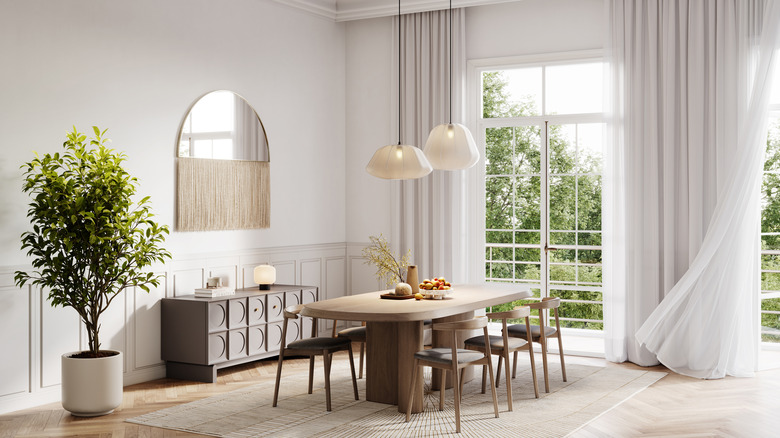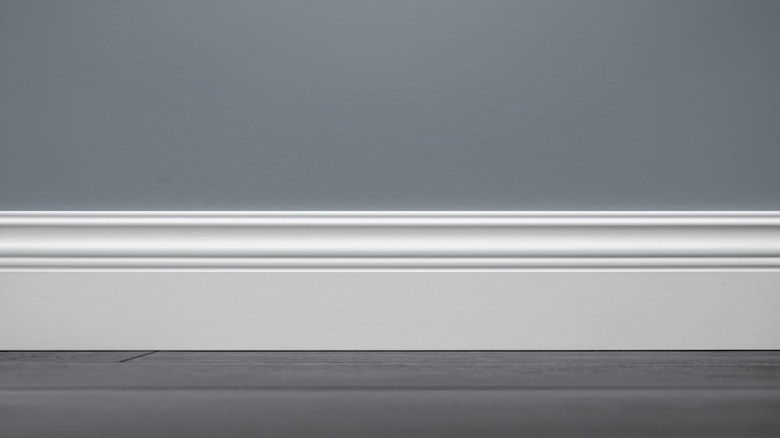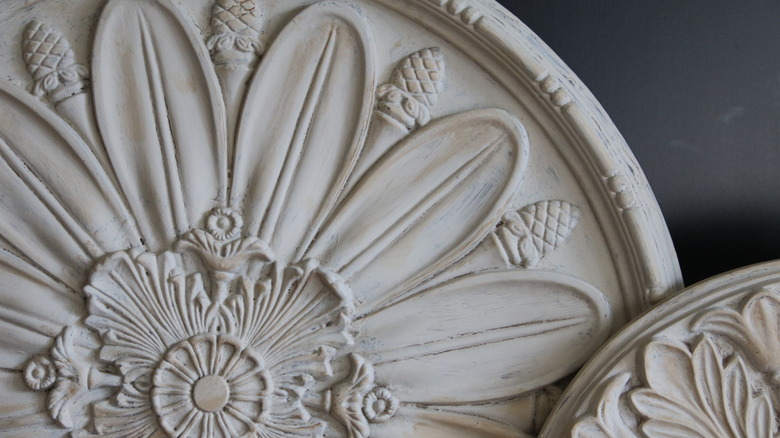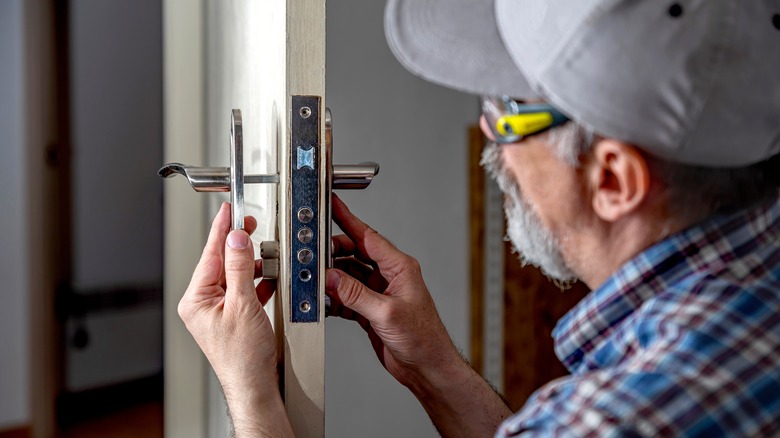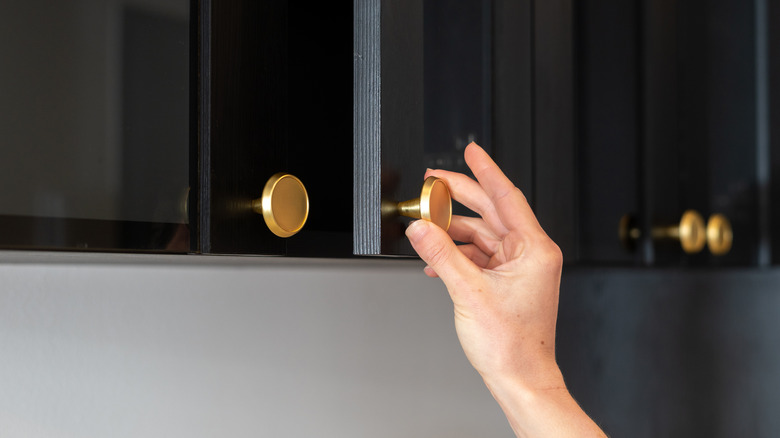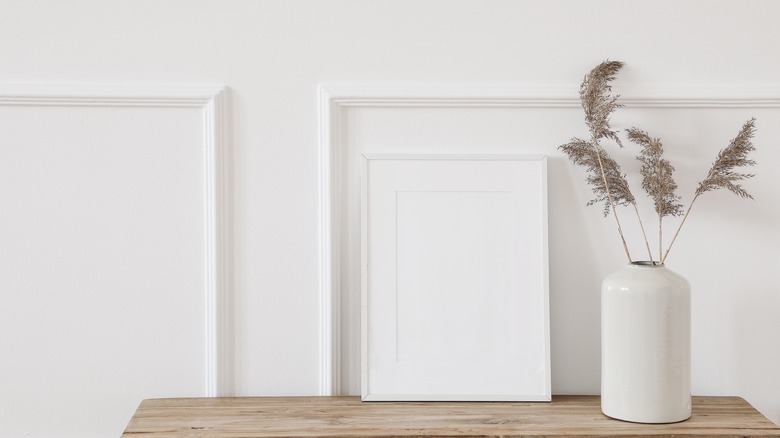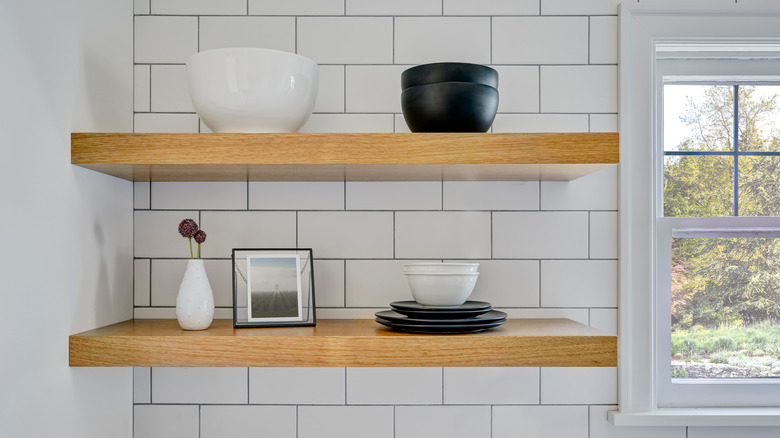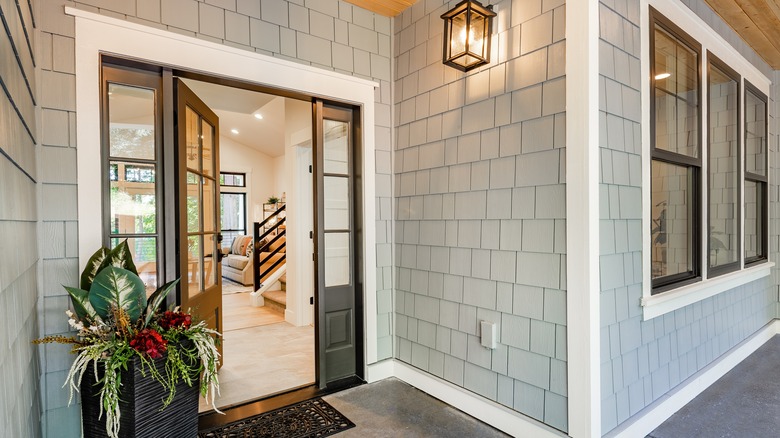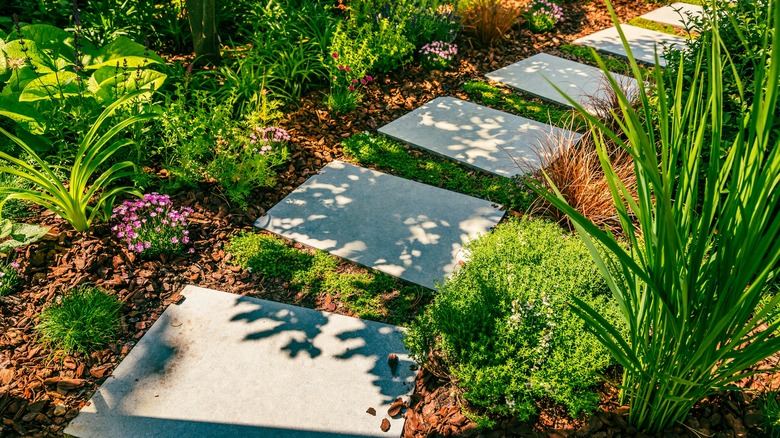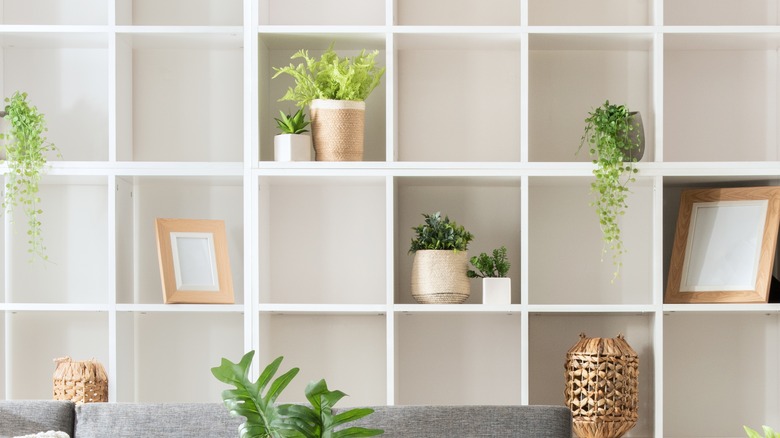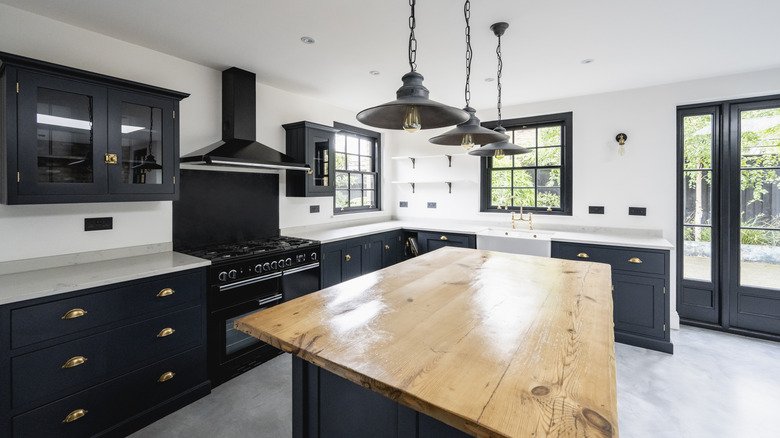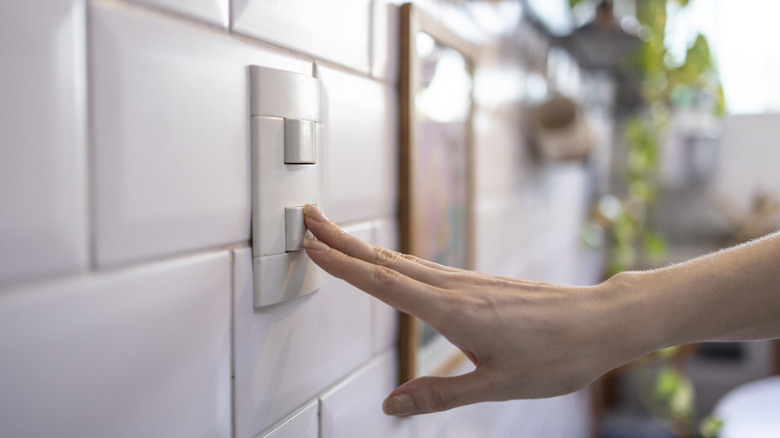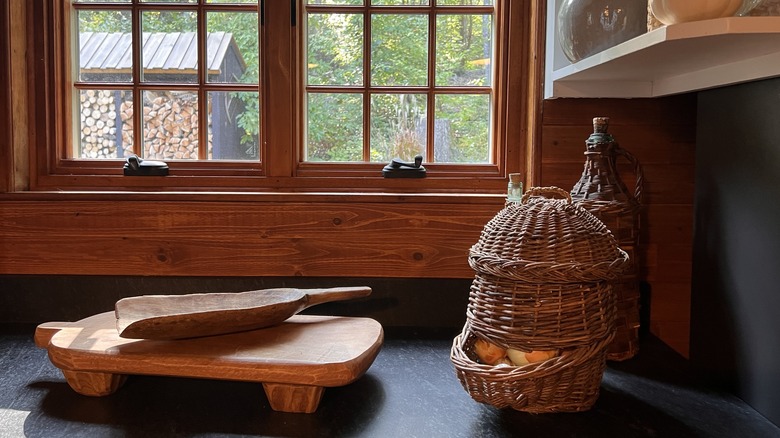Home Renovation Hacks That Fake A Much More Expensive Look
Are you itching to press go on some home improvement projects? The right renovations can leave you with a beautiful house that sparks pleasure and increases your property value. Data from the National Association of Realtors (NAR) revealed that enjoyment of their space spiked in almost 70% of surveyed homeowners, and 84% reported an increased desire to be in their abodes post-improvements.
But like most things worth doing, home renovations aren't without their (at times immense) challenges. Remodeling projects can be highly disruptive and turn into a massive money pit if you're not careful. According to a survey done by Discover Home Loans, (via Business Wire), over 57% of renovators busted through their budgets.
Home improvement certainly isn't cheap, and there is lots of room for cost creep. But it is possible to decorate on a dime, provided you have the right tricks up your sleeve. Whether you're renovating on a shoestring but want to create a luxe look, or simply wish to make sure you don't wind up spending more than planned –- here is a list of semi-brilliant home reno hacks that can help. These savvy solutions can make your space look grander, more expensive, and ultra-well-appointed, without requiring you to start eyeing up your retirement savings. They run the gamut from faking the look of lofty ceilings to upgrading how certain elements of your home feel in your hands. So save yourself some serious money, and sit back for the ultimate list of low-budget, high-style hacks.
Make your ceilings look taller with some clever tricks
One of the things that's very difficult, expensive, and sometimes even impossible to change in a house is ceiling height. In a two-story home, the height of the ground floor rooms is set by the upper story. If you have attic space above your ceiling, you may be able to vault your roof, but this is structurally complicated, not a job for DIYers, and usually costs between $18,000 and $25,000. If you want the aesthetic of soaring ceilings without the expense, here are some hacks that can help fake the feel of more headroom. First, make sure you mount your curtain rods high up on the wall. Second, invest in drapes that reach the floor. Not only will this increase the visual height of the room, but floor-to-ceiling drapes will automatically look more high-end. If you can't find drapes that are the exact right length and aren't handy with a needle, hem them up to fit with some iron-on hem adhesive from Amazon.
Using wallpaper with vertical lines in the pattern is another way you can trick the eye into thinking a room is taller. And don't think you have to opt for big, bold, circus tent-type stripes. A subtle pinstripe or any kind of pattern that creates vertical lines can work. Finally, if you're opting for a dark, drama-laden wall color, wrapping the room in it by painting the ceiling as well can help create the illusion of extra height.
Bulk up your trim
Another way you can make your home feel well-appointed on the cheap is by beefing up your baseboards and trim. Thin, builder-grade baseboards do not give off opulent vibes, instead, they can feel skimpy and basic. One of the easiest and cheapest ways to elevate skinny skirting boards is by adding a strip of molding right on top. Not only will this increase the height, but the molding will also add detail. To make the installation seamless, caulk the top and paint the old and new trim in the same color. For an even cheaper fix, you can also mount a thin strip of beading about 2 inches above your existing trim.
You can apply this same hack to door casings. Replacing door trim can be tricky, but adding some extra molding is relatively easy. Simply adhere a strip of flat baseboard to the top of your doorframe, and then add a length of crown molding to the top. The result? A more ornate, detailed effect that can also make your doorways look taller, and, as a result, more expensive.
Go luxe with your light fixtures and add ceiling medallions
If you want your space to ooze luxury, upgrading your light fixtures is a must. Yes, new light fittings aren't cheap, but they can radically transform the feeling of your home. If you've got a boob light blessing your entryway, switching it out for a modern, sculptural lighting fixture, or even a chandelier, can create full-on foyer vibes. And if you don't want to spend a lot, there are affordable light fixtures out there that won't break the bank. For those with fancy tastes, Amazon sells this ornate crystal chandelier for under $200. If you're after a more contemporary look, you can pick up a mid-century modern chandelier for around $100 (also available on Amazon).
While you're swapping out light fixtures, here's another impactful hack that can add oodles of expensive-looking style to your space. Install ceiling medallions. Ceiling medallions have graced US homes since the 1700s, and they used to be a status symbol, as not everyone could afford intricate molding and millwork — or even, for that matter, central hanging lights. Nowadays, you can snag ceiling medallions for under $150, such as this hand-painted one from Walmart. The Home Depot also sells a wide range of styles. To install, you will need to measure and cut a hole in the center, then adhere the medallion in place with adhesive caulk and trim-head screws. If you're getting an electrician in to install your new light fixtures, you can ask them to mount the medallions at the same time.
Swap out builder-grade, hollow-core interior doors
A hollow-core door won't impact the look of your space, but it will definitely influence the feel of it. Solid wood doors feel heavier in the hand when you open them, which automatically conveys a subtle sense of luxury and quality. They're also better at soundproofing. Replacing any hollow-core doors in your home will require a bit of money upfront, but it can be a cost-effective choice over time. Not only will solid-core doors elevate your home, but they'll last far longer. Hollow-core doors are very susceptible to damage, and even a small bump can leave a dent that's hard to hide. Solid-core doors can be sanded down and refinished for decades to come.
However, if you don't have the budget to blow a few hundred dollars on doors, here's a money-saving hack for the interim. Take your existing doors and give them an expensive look by installing picture molding trim on the fronts. Simply choose some trim from the hardware store, cut it to length (making 45-degree angle cuts), and adhere it to your doors with construction adhesive and some brad nails. If you want an even easier method, you can also use self-adhesive, flexible chair rail molding from Amazon which you can cut with a utility knife.
Invest in your home's hardware
According to Erin Napier, hardware is a small adjustment that can have a big impact on your home. Often referred to as the jewelry of spaces, hardware helps to tie your overall design together and make a room pop. But unthoughtful hardware selections can also do the opposite. Randomly chosen hardware that's jumbled all together in the same house can smack of hasty DIY remodels and feel devoid of design. If you want to leverage hardware to create a luxurious aesthetic in your home, here are some things to consider.
First off, think carefully about what types of metals you want to use. Mixing metallic finishes in your décor is totally fine and can create a subtly dynamic look. But combining multiple metals together is more complicated than choosing just one. If spending an afternoon playing around with samples isn't your idea of a good time, then feel free to pick one finish and run with it throughout your entire home. If you do this, you'll want to keep the finish consistent across all elements, including sneaky things like door hinges, shower rods, curtain rods, and floor vents.
Alternatively, if you want to mix metals, here are some hot tips. First, pick your main player. If you have any large metal elements, like appliances or a range hood, their finish will be the automatic choice. From there, add a couple of accent metals. For the ultimate balance, try combining warm and cool tones.
Add an old-world feel with picture frame molding
Installing picture frame molding is a simple, high-impact hack that can inject instant romance and extra architectural detail. Decorative moldings have long been associated with luxury and have acted as interior status symbols, thanks to the labor and skill required to carve them. Nowadays, molding is relatively cheap and easy to install, but it still gives off an elevated look. Picture frame molding (also known as wall frame molding and shadow box molding) is having a decided moment in interior design. This is part of a general resurgence of traditional elements. Picture frame molding will look right at home in a historical house, but streamlined versions can also work well in more contemporary spaces. It can give off a similar feeling to wall panels, but where installing paneling can cost over $4,000 for an average-sized room, you can DIY a few squares of wall frame molding for under $200. To mount it, you will need to cut some trim (such as this wall and cabinet molding from Home Depot) to size at an angle, apply adhesive to the back, and nail it to your drywall.
Start by figuring out what size "boxes" you want to create. There are lots of different configurations, ranging from one large rectangle per wall, to multiple ones, either above or below chair rails or running the height of the wall. Taping out different configurations can give you an idea of how they complement your space. Once you've taped off your final arrangement, measure the sides of the boxes and use these for cutting measurements. If you're planning on painting the trim a contrasting color to your wall, do this before mounting the pieces and starting with a coat of primer.
Go taller with your tile backsplash
Are you about to renovate your backsplash? Taking backsplash tile to the ceiling is a simple way to make your kitchen feel high-end and designer-grade. Going higher will increase the total price tag, but there are ways to work around this. The average cost of tiles can range anywhere from $10 to $95 per square foot. Choosing a tile on the lower end could create enough room in your budget to cover the whole wall instead of a skinny strip. A beautiful, tall expanse of cheaper tile can create far more visual impact than a thin strip in a pricier option. In fact, doing a ceiling-height backsplash is one of the best ways to make budget tile look expensive.
If you are removing any upper cabinets in favor of the open shelving trend, you'll have to cover the entire wall to get the look. But if you're keeping your uppers, the only extra areas you'll need to tile might be narrow strips of wall around them, which can make the upgrade even more cost-effective while still giving off a luxe look.
Spruce up your front door
According to data from Realm, via Yahoo! News, a front door refresh can net home sellers an ROI of nearly 500%. In other words, smartening up your entrance can elevate the perceived value of your entire property. One of the easiest ways to refresh a front door is giving it a new coat of paint. For an extra-expensive aura, black paint is a great bet. According to research from Zillow, painting a front door black can boost a home's value by almost $6,450.
If you want to elevate your entrance even further, pimp it out with some sexy lighting. You can go with a decorative wall sconce or lantern, and amp up the mood even further with some uplights or downlights. If you have any planters or shrubbery nearby, highlight them with a couple of spike lights. Speaking of planters, if your doorway is still looking a little plain, flanking it with two large pots can add an elegant, impactful touch.
Do some light landscaping
Large landscaping overhauls usually aren't cheap, but there's a lot you can do that won't break the bank. Start by tackling any general maintenance tasks, like weeding, pruning, and tidying up borders. Take stock of the existing plants in your yard (you can use plant ID apps for species you're unsure of) and remove any invaders. Once you know what you've got, see if you can fill in gaps by moving, splitting, or propagating plants you already have. Then dress your borders in a blanket of mulch. This will give them a high-end, professionally landscaped look and help reduce weeds and water evaporation from the soil.
If your lawn is looking a little lackluster, show it some love with regular watering, mowing, and fertilization. If it's uneven, try topdressing it and apply a little extra lawn dressing to the dips to fill them out over time. If there are bare, well-trodden areas that simply don't want to grow because they get too much foot traffic, laying down some pavers can create a neat path. To smarten things up even further, flank your path with narrow borders and shrubs. And if you want to fake the look of an expensive outdoor lighting system, pick up some inexpensive solar garden lights from Amazon. Place them along any paths or next to plants you want to highlight.
Use IKEA shelves to create your own built-ins
Built-in bookshelves can cost, on average, anywhere between $1,400 and $4,750 to have professionally installed. But if you're handy and have a few basic tools, you can get the custom look for less with just a couple of pre-built shelves. For instance, you can fake a built-in cabinet with IKEA HAVSTA pieces by simply assembling them to fit your space and then painting the cabinets the same color as your walls. Adding trim pieces to the front can help customize them even further and help hide any gaps.
The HAVSTA system is one of IKEA's pricier cabinet lines, so if you're looking to save even more dollars, you can use one of their cheaper ranges, such as the BILLY or KALLAX shelves. Not only are these inexpensive bookcases ideal for faking built-in cabinets, but you can also turn one on its side to create a chic banquette bench. Add some cushions to the top and doors to the front for extra concealed storage.
Spray paint your kitchen cabinets
Painting cabinet fronts is one of the most affordable kitchen facelifts. If you want the final finish to feel expensive, opt for spraying over painting with a roller and brush. Spraying will give your cabinets an ultra-smooth finish that's free from brush marks.
If you hire a professional painting service for the job, this will cost you between $40 and $100 per linear foot of cabinetry. If you opt to do the work yourself, you can bring this cost down, but you will need to either buy or rent a sprayer. The cheapest paint sprayer at Home Depot costs just under $70. You can also pick up a paint sprayer on Amazon with good reviews for a similar price. Before spraying, make sure you tape off and protect everything in the vicinity, or opt to brush the frames and create a paint booth to spray the doors. If you're painting over wood, you will need to apply a stain-blocking primer.
Upgrade your outlet covers and install dimmer switches
Old, cruddy outlet covers aren't cute, and swapping them out for fresh ones is an easy update that will get you some serious bang for your buck. You can opt for plain white ones, or go designer-grade and splurge on some beautiful bronze wall plates from Amazon. Alternatively, make those plates disappear by picking up some paintable outlet covers, like these from Amazon. Give them a couple coats of your wall color and click those babies into place.
While you're upgrading your outlet covers, consider installing dimmer switches. Loved by designers, dimmable lights allow you to adjust the mood, create a cozy ambiance, and enjoy the luxury of soft lighting. Dimmer switches typically cost between $10 and $25 a piece, and professional installation will run you roughly $80-$200 per switch. Familiar with electrics? You may be able to install them yourself, but don't attempt this DIY if wiring isn't your forte.
Get a soapstone look for less
If you're an avid consumer of interiors content, you've probably noticed soapstone countertops popping up in your feed and favorite designers' projects. Soapstone offers a soft, welcoming look that's right in line with the organic modern design movement. But here's the kicker. Soapstone can cost even more than marble, averaging out to between $70 and $120 per square foot after installation.
If you're in love with the look of soapstone but not its price tag, HGTV's Erin Napier has an ingenious hack that she and her husband implemented in their staycation home. During the reveal on "Home Town" (via HGTV), Ben Napier said, "We wanted soapstone, but our pocketbooks didn't," so the couple opted for Black Mist leathered granite, which, according to Erin Napier, "is the exact same look [as soapstone] and also [a fraction] of the price." Honed and leathered granite is slightly more expensive than polished, and it also requires more regular sealing. But it's certainly a clever and cost-effective dupe. Besides Black Mist, Green Ocean, Costa Esmeralda, Jet Mist, and Virginia Mist are four other types of granite that can look similar to soapstone. Going with a leather finish (not to be confused with honed) is key.

